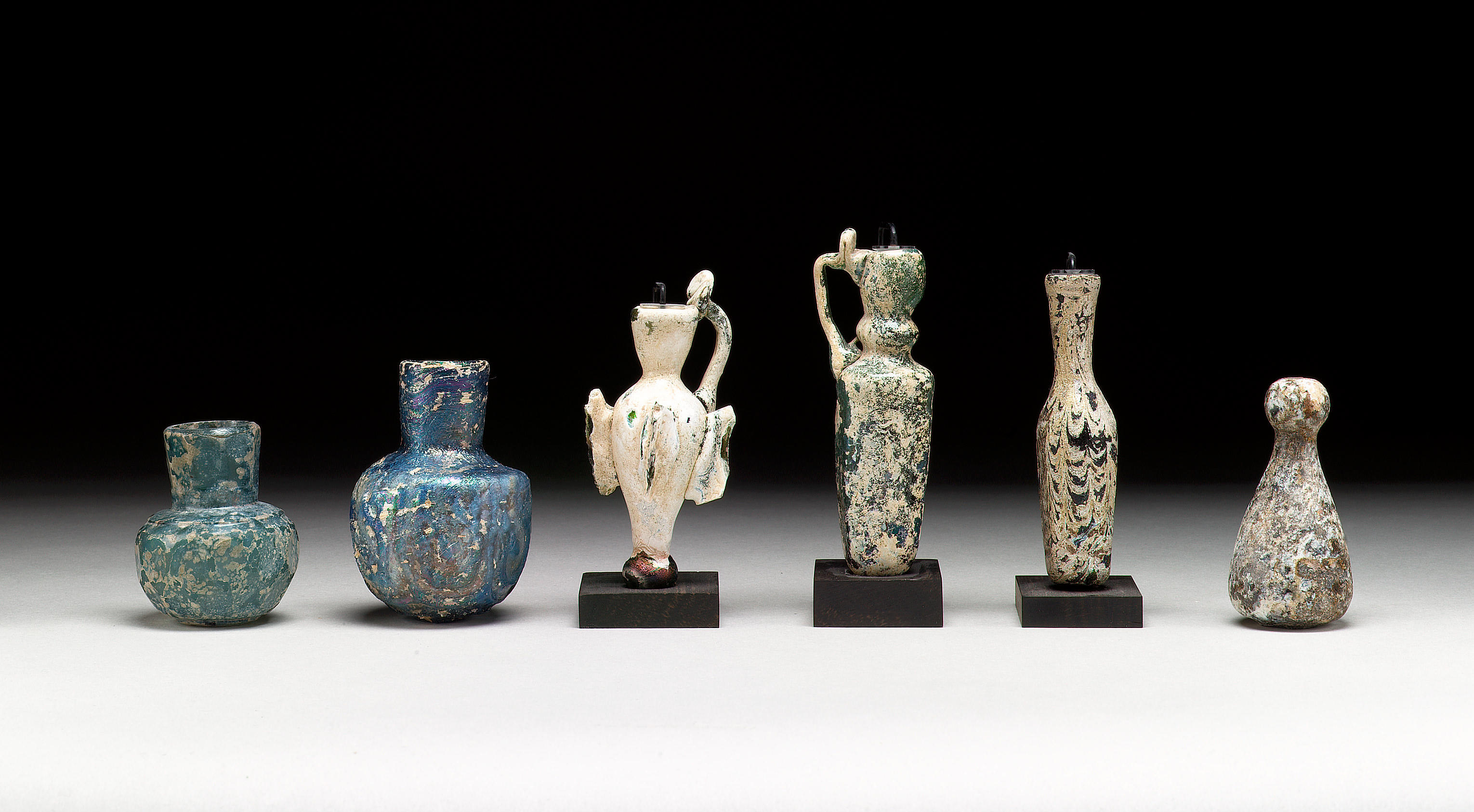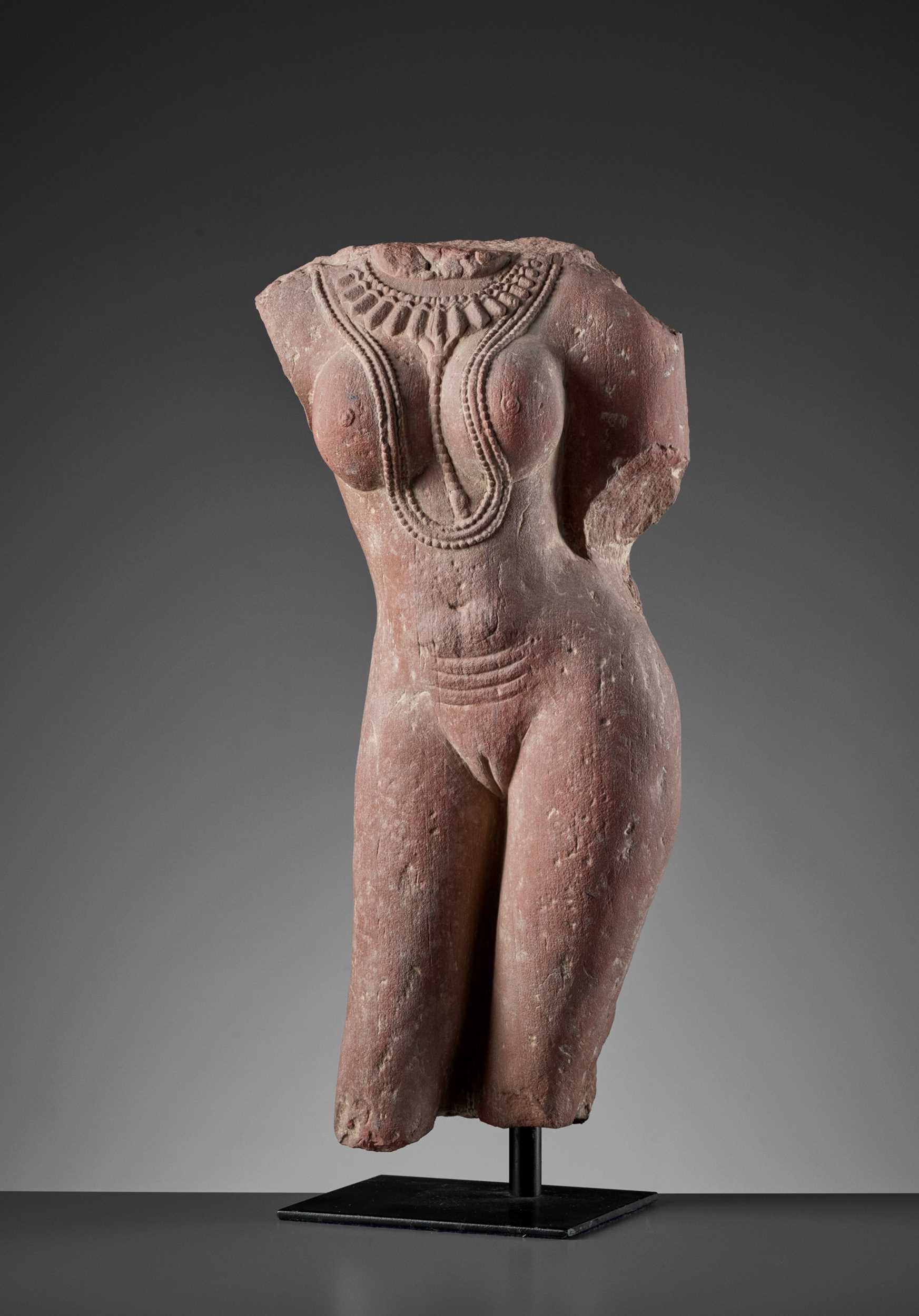(Islamic & Indian Art, 29th October 2020) A BLACK STONE TORSO OF A STANDING BUDDHA Bihar, North-Eastern India, Pala period, 9th - 10th century A BLACK STONE TORSO OF A STANDING BUDDHA PROPERTY FROM A PRIVATE BELGIAN COLLECTION Bihar, North-Eastern India, Pala period, 9th - 10th century Carved in three dimensions from a single boulder of either black schist or phyllite, resting against a flat back possibly once a cusped stele, the body standing upright in a slight tribhanga pose (triple flexion), the left hand resting against the shoulder, clenching onto a rounded element now missing, the right hand in the varadamudra (compassion, gift-giving gesture) showing the inside lines of the palm to the beholder, the multi-pleated and diaphanous ankle-length sanghati (monastic robe) clinging tightly onto the Buddha's body showcasing his anatomy, the neck with two out of three lines, symbolizing the three forms of Buddhist training (conduct, concentration and wisdom) according to the Sutras, the back drilled in four points, possibly once mounted on a higher structure, resting on a black metal stand, 67cm x 40cm including the mount. Provenance: Acquired by the present vendor from an auction of a private early 20th-century Belgian estate in Antwerp, in 2018. Exhibited: Asian Art in London, An Important Group of Sculptures from India, Southeast Asia and China, at Jonathan Tucker and Antonia Tozer Gallery, 1st - 23rd November 2018. Historians have often argued that the architecture and sculptural reliefs of post-Gupta India (7th - 12th century) are dominated by Hinduism, exemplifying a change of heart from earlier periods, when Buddhism prevailed (Robert Fisher Buddhist Art and Architecture, 1993, pp. 62 - 64). And it is precisely around this time, during the so-called Medieval Period, that the Pala dynasty spearheaded and fostered the creation of some of the finest examples of Buddhist art in Bihar and in India's North-Eastern territories. Showing elements of both indebtedness and departure from the Gandhara and Gupta traditions, Pala Buddhist sculptures dare to expand the repertoire of represented subjects, perhaps also thanks to the influence of Vajrayana teachings. These sculptures are often instilled with a higher charge of sensuousness: forms become more elongated and slender, and a more plastic approach to human bodies is adopted. Some of these characteristics can be appreciated in our torso, in which the proportions between shoulders, waist and legs appear to be respecting natural volumes. The gently enhanced tribhanga pose hints at a nuance of movement, despite the stillness of the rock, and the rounded hips are not as exaggerated as in earlier models. A similar example to our torso can be found in Susan L. Huntington, The Pala-Sena Schools of Sculpture, 1984, fig. 116. 67cm x 40cm including the mount.
(Islamic & Indian Art, 29th October 2020) A BLACK STONE TORSO OF A STANDING BUDDHA Bihar, North-Eastern India, Pala period, 9th - 10th century A BLACK STONE TORSO OF A STANDING BUDDHA PROPERTY FROM A PRIVATE BELGIAN COLLECTION Bihar, North-Eastern India, Pala period, 9th - 10th century Carved in three dimensions from a single boulder of either black schist or phyllite, resting against a flat back possibly once a cusped stele, the body standing upright in a slight tribhanga pose (triple flexion), the left hand resting against the shoulder, clenching onto a rounded element now missing, the right hand in the varadamudra (compassion, gift-giving gesture) showing the inside lines of the palm to the beholder, the multi-pleated and diaphanous ankle-length sanghati (monastic robe) clinging tightly onto the Buddha's body showcasing his anatomy, the neck with two out of three lines, symbolizing the three forms of Buddhist training (conduct, concentration and wisdom) according to the Sutras, the back drilled in four points, possibly once mounted on a higher structure, resting on a black metal stand, 67cm x 40cm including the mount. Provenance: Acquired by the present vendor from an auction of a private early 20th-century Belgian estate in Antwerp, in 2018. Exhibited: Asian Art in London, An Important Group of Sculptures from India, Southeast Asia and China, at Jonathan Tucker and Antonia Tozer Gallery, 1st - 23rd November 2018. Historians have often argued that the architecture and sculptural reliefs of post-Gupta India (7th - 12th century) are dominated by Hinduism, exemplifying a change of heart from earlier periods, when Buddhism prevailed (Robert Fisher Buddhist Art and Architecture, 1993, pp. 62 - 64). And it is precisely around this time, during the so-called Medieval Period, that the Pala dynasty spearheaded and fostered the creation of some of the finest examples of Buddhist art in Bihar and in India's North-Eastern territories. Showing elements of both indebtedness and departure from the Gandhara and Gupta traditions, Pala Buddhist sculptures dare to expand the repertoire of represented subjects, perhaps also thanks to the influence of Vajrayana teachings. These sculptures are often instilled with a higher charge of sensuousness: forms become more elongated and slender, and a more plastic approach to human bodies is adopted. Some of these characteristics can be appreciated in our torso, in which the proportions between shoulders, waist and legs appear to be respecting natural volumes. The gently enhanced tribhanga pose hints at a nuance of movement, despite the stillness of the rock, and the rounded hips are not as exaggerated as in earlier models. A similar example to our torso can be found in Susan L. Huntington, The Pala-Sena Schools of Sculpture, 1984, fig. 116. 67cm x 40cm including the mount.

.jpg)
.jpg?w=400)
.jpg)
.jpg)



.jpg)






Try LotSearch and its premium features for 7 days - without any costs!
Be notified automatically about new items in upcoming auctions.
Create an alert